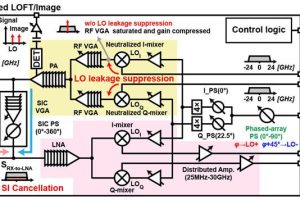
“In general, such ultra-high-speed data transmission experiments are performed using multi-level modulations via a complex system with high power consumption that uses off-line or on-line digital signal processing,” said team leader Masayuki Fujita. “The present real-time demonstration, which uses the simplest OOK [on-off keying] format, shows the capability of ultra-broad band terahertz waves. Our achievement demonstrates the usefulness of terahertz waves and is expected to accelerate research and development activities for the realisation of ‘beyond 5G’, and eventually 6G.”
The researchers created a two-channel terahertz transmitter, creating carriers using pairs of lasers with wavelengths in the 1.55μm band, but differences in the 300GHz band (see diagram). The 8K video source was intensity-modulated onto the signal with an ultra-fast photodiode.
The video source was commercial uncompressed 8K from Astrodesign, sent as a four-channel 12Gbit/s signals combined to form two separate RF channels modulated at 24Gbit/s.
 Coherent reception for each RF channel was through resonant tunnel diodes using a high-sensitivity technique revealed by Osaka just over a year ago, where the detector is a self-oscillating tunnel diode (oscillating in its negative resistance region). Injection-locking tends to synchronise the diode’s oscillation with the received signal, resulting in high-sensitivity coherent detection of incoming THz waves using a single resonant tunnel diode. “Among all electronic-based systems, ours achieved the highest error-free wireless transmission data rate,” said researcher Yousuke Nishida at the time.
Coherent reception for each RF channel was through resonant tunnel diodes using a high-sensitivity technique revealed by Osaka just over a year ago, where the detector is a self-oscillating tunnel diode (oscillating in its negative resistance region). Injection-locking tends to synchronise the diode’s oscillation with the received signal, resulting in high-sensitivity coherent detection of incoming THz waves using a single resonant tunnel diode. “Among all electronic-based systems, ours achieved the highest error-free wireless transmission data rate,” said researcher Yousuke Nishida at the time.
The two detected and decoded 24Gbit/s streams were then split back into four channels for an HDMI connection to an 8K monitor (see photo).
 Electronics Weekly Electronics Design & Components Tech News
Electronics Weekly Electronics Design & Components Tech News



